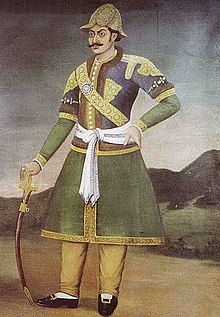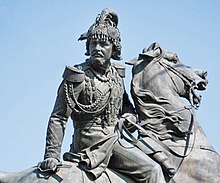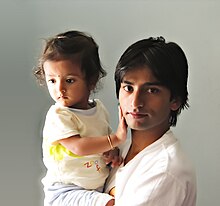Chhetri
क्षेत्री/खस | |
|---|---|
 Portrait of a Chhetri "Queen Tripurasundari of Nepal" who ruled the country as a Queen regent from 1806 -1832 | |
| Regions with significant populations | |
| 4,796,995 (16.4% of Nepal's population) (2021)[1] | |
| Languages | |
| Nepali (Khas-Kura), Dotyali (Doteli)[2] | |
| Religion | |
| Hinduism 99.25% (2011), Christianity 0.6% (2011)[3] | |
| Related ethnic groups | |
| Khas peoples Bahun, Thakuri, Kumaoni, Magar, and other Indo-Aryan peoples | |
Chhetri (Kshetri, Kshettri, Kshetry or Chhettri), (Nepali: क्षेत्री pronounced [tsʰetri]; IAST: Kṣetrī) historically called Kshettriya or Kshetriya or Khas are Nepali speaking Rajputs historically associated with the warrior class and administration, some of whom trace their origin to migration from medieval India.[4][5] Chhetri was a caste of administrators, governors, warriors and military elites in the medieval Khas Kingdom and Gorkha Kingdom (later unified Kingdom of Nepal).[6] The nobility of the Gorkha Kingdom mainly originated from Chhetri families. They also had a strong presence in civil administration affairs.[7] The bulk of prime ministers of Nepal before the democratization of Nepal belonged to this caste as a result of the old Gorkhali aristocracy. Gorkha-based aristocratic Chhetri families included the Pande dynasty, the Basnyat dynasty, the Kunwar family (and their offspring branch, the autocratic Rana dynasty) and the Thapa dynasty.
Khas Chhetris were traditionally considered a division of the Khas people with Khas Brahmin (commonly called Khas Bahun).[8] They make up 16.45% of Nepal's population according to the 2021 Nepal census, making them the most populous caste or ethnic community in Nepal.[9] Chhetris speak an Indo-Aryan Nepali language (Khas-Kura) as mother tongue.[2][4]
Etymology and background
Chhetri is considered a direct derivative of the Sanskrit word Kshatriya from the root kṣatra meaning "rule or authority" which was associated with the ruling and warrior class of Hindu society.[10][11][12] According to the 1854 Legal Code (Muluki Ain) of Nepal, Chhetris were a social group among the sacred thread bearers (Tagadhari) and twice-born people of the Hindu tradition.[13][14] Almost all Chhetris are Hindu.[15]
The term 'Chhetri' was adopted by a lot of the high-ranking Khas after the unification of Nepal,[16] and it was formalized by an order of Bir Narsingh Kunwar(Jang Bahadur Rana), who considered their original name (Khasa) to be derogatory.
The family occupation of Chhetris

The caste system of Nepal was decided according to the occupation they did from the ancestors of their family, known as Dharma (Devanagari:धर्म). The family occupation of Brahmin was Guru or the spiritual leader in Hinduism whereas that of Chhetri was military and political leaders. Hence, the majority of military and politicians are occupied by Chhetris until now. [note 1]
History


They are thought to be connected to the Khasas mentioned in the ancient Indian literature and the medieval Khasa kingdom.[17] In the early modern history of Nepal, Chhetris played a key role in the Unification of Nepal, providing the core of the Gorkhali army of the mid-18th century.[18] Bir Bhadra Thapa was a Thapa of Chhetri group[19] and leading Bharadar during Unification of Nepal.[20] His grandson Bhimsen Thapa became Mukhtiyar (Prime Minister) of Nepal.[20] Swarup Singh Karki, a leading politician and military officer, belonged to Chhetri family.[21] Abhiman Singh Basnyat of Basnyat dynasty, Damodar Pande of Pande dynasty were both members of Chhetri caste.[22] and Jung Bahadur Rana, founder of Rana dynasty also belonged to the Chhetri community.[23] For 104 years since the middle of the 19th century until 1951, hereditary Rana prime ministers wielded absolute rule in the country relegating the monarchy to a mere figurehead.[24]
During the monarchy, Chhetris continued to dominate the ranks of the Nepalese government, Nepalese Army, Nepalese Police and administration.[18]
Chhetri noble families

The most prominent feature of Nepalese Chhetri society has been the Rana Prime Ministers (1846–1953), the Pande family, the Thapa family, and the Basnyat family,[7] all of whom held prominent positions in the Gorkha kingdom, and increased the Chhetri presence in the armed forces, police, and Government of Nepal. In traditional and administrative professions, Chhetris were given favorable treatment by the royal government.[25][26]
Chhetri and premiership
The nobility of Gorkha were mainly from Chhetri families and they had a strong presence in civil administration affairs.[7] All of the Prime Minister of Nepal between 1768 and 1950 were Chhetris with the exception of Ranga Nath Poudyal, being a Bahun, and Fateh Jung Shah, being a Thakuri.[27] These number varied after the democratization of Nepal. Between 1951 and 1997, out of the 16 Prime Ministers of Nepal, 5 of them were Chhetris.[28]

| S.N. | Name | Took office | Left Office | Notes |
|---|---|---|---|---|
| 1 | Vamsharaj Pande | 1776 | 1779 | again from 1782-1785 |
| 2 | Swarup Singh Karki | 1776 | 1777 | |
| 3 | Abhiman Singh Basnyat | 1785 | 1794 | |
| 4 | Kirtiman Singh Basnyat | 1794 | 1801 | |
| 5 | Bakhtawar Singh Basnyat | 1801 | 1803 | |
| 6 | Damodar Pande | 1803 | 1803 | |
| 7 | Bhimsen Thapa | 1806 | 1837 | |
| 8 | Rana Jang Pande | 1837 | 1837 | again from 1839-1840 |
| 9 | Mathabar Singh Thapa | 1843 | 1845 | |
| 10 | Jung Bahadur Rana | 1846 | 1856 | again from 1857-1877 |
| 11 | Bam Bahadur Kunwar | 1856 | 1857 | |
| 12 | Krishna Bahadur Kunwar Rana | 1857 | 1857 | |
| 13 | Ranodip Singh Kunwar | 1877 | 1885 | |
| 14 | Bir Shumsher Jung Bahadur Rana | 1885 | 1901 | |
| 15 | Dev Shumsher Jung Bahadur Rana | 1901 | 1901 | |
| 16 | Chandra Shumsher Jung Bahadur Rana | 1901 | 1929 | |
| 17 | Bhim Shumsher Jung Bahadur Rana | 1929 | 1932 | |
| 18 | Juddha Shumsher Jung Bahadur Rana | 1932 | 1945 | |
| 19 | Padma Shumsher Jung Bahadur Rana | 1945 | 1948 | |
| 20 | Mohan Shumsher Jung Bahadur Rana | 1948 | 1951 | |
| 21 | Surya Bahadur Thapa | 1955 | 1955 | again from 1963-1964;
1965-1969, 1979-1983, 1997-1998, 2003-2004 |
| 22 | Subarna Shamsher Rana | 1958 | 1959 | |
| 23 | Kirti Nidhi Bista | 1969 | 1970 | again from 1971-1973;
1977-1979 |
| 24 | Sher Bahadur Deuba | 1995 | 1997 | again from 2001-2002;
2004-2005, 2017-2018, 2021-2022 |
Military achievements


Chhetri had dominated high military positions and monopolized the military force at the times of Chhetri autocratic administrators like PM Bhimsen Thapa and PM Jung Bahadur Rana. There were 12 Basnyats, 16 Pandes, 6 Thapas and 3 Kunwar officers totalling to 51 Chhetri officers in the year 1841 A.D.[23] The most prominent officers at Shah administration were the Kazis which had control over civil and military functions like a Minister and Military officer combined. Rana Jang Pande, the leader of Pande faction, was the Prime Minister of Nepal in 1841 A.D.[29] which might have caused an increase in the number of Pande officers at 1841. After the rise Rana dynasty(Kunwars), the number changed to 10 Basnyats, 1 Pandes, 3 Thapas and 26 Kunwar officers totaling to 61 Chhetri officers in the year 1854 A.D.[23]Chhetris dominated the position of the senior officers of the Nepali Army comprising 74.4% of total senior officers in 1967. Similarly, Chhetris composed 38.1%, 54.3% and 55.3% of the senior officers in the year 2003, 2004 and 2007 respectively.[30]



Anglo-Nepalese War and Nepal-Tibet War
Chhetri commanders and generals of the military campaigns of the kingdom of Nepal have shaped the political course of the country overwhelmingly. Anglo-Nepalese War fought between the British forces and the army of Kingdom of Nepal was commanded by Bhimsen Thapa, Amar Singh Thapa, Ujir Singh Thapa, Ranabir Singh Thapa, Dalbhanjan Pande, Bakhtawar Singh Thapa and Ranajor Singh Thapa from 1814 to 1816 and led to a peace treaty with the British and maintained the independence of Nepal during the British Company rule and British Raj in South Asia from 18th to 20th century.[31]
Nepal-Tibet War (1855-1856), commanded by Bam Bahadur Kunwar, Sanak Singh Khatri, Prithvi Dhoj Kunwar, Dhir Sumsher and Krishna Dhoj Kunwar under the authority of Jung Bahadur Rana, resulted in the victory of Nepalese troops whereby the Tibetans had to pay an annual subsidy of ten thousand rupees to Nepal and were made to allow the establishment of a Nepalese trading station and agency in Lhasa.[32]
Families & surnames

Surnames of Chhetris include, among others:[33]
- Adhikari
- Baniya
- Basnet
- Bisht
- Bhandari
- Bohra
- Burathoki
- Chauhan
- Gharti
- Gusain/Gosain
- Karki
- Khadka
- Khatri
- Khulal
- Kunwar
- Mahara
- Negi
- Pande/पाँडे (not to be mistaken with Brahmin Pandey)
- Rana
- Raut
- Rawal
- Rawat
- Rayamajhi
- Rokka
- Thapa
Demographics


The Central Bureau of Statistics of Nepal classifies Chhetris as a subgroup within the broader social group of Khas Arya (together with Thakuri and Sanyasi/Dasnami).[34] The 2021 census recorded Chhetri population of Nepal as the largest community with a population of 4,796,995 (16.4% of Nepal). Previously, the 2011 Nepal census showed Chhetris as the largest Hindu adherents in the nation with 4,365,113 people which was 99.3% of total Chhetri population.[35] In Nepal's hill districts the Chhetri population rises to 41% compared to 31% Brahmin and 27% other castes. This greatly exceeds the Kshatriya portion in most regions with predominantly Hindu populations.[36][37]
As per 2021 census, Chhetris are largest caste group in 27 districts of Nepal, increase from 21 districts of 2001 Nepal census and 24 districts of 2011 Nepal census. [38] These twenty seven districts are - Sankhuwasabha district, Okhaldhunga district, Dhankuta district, Morang district, Udayapur district, Dolakha district, Ramechhap district, Gulmi district, Dang district, Salyan district, Western Rukum district, Surkhet district, Dailekh district, Jajarkot district, Dolpa district, Jumla district, Mugu district, Humla district, Bajura district, Bajhang district, Achham district, Doti district, Dadeldhura district, Baitadi district, Darchula district, Kalikot district, and Kanchanpur district.
The district with the largest Chhetri population is Kathmandu district with 424,172 (i.e. 20.7% of the total district population).[35] [38] Chhetris form the second largest demographic group after Newars in the Kathmandu Valley, together with Lalitpur (Patan) and Bhaktapur, with a population of 621,346. Other districts with more than 150,000 Chhetri population are Kailali, Kanchanpur, Dang, Jhapa and Morang. [38]
Province wise, Chhetris are majority demography in Koshi Province, Karnali Province and Sudurpashchim Province. [38] The frequency of Chhetris by province is shown in the table:[39]
| Province | Percentage of Provincial population | Demographic Status |
|---|---|---|
| Karnali Province | 42.2% | largest |
| Sudurpashchim Province | 41.7% | largest |
| Bagmati Province | 17.4% | 3rd largest |
| Koshi Province | 15% | largest |
| Lumbini Province | 14.2% | 3rd largest |
| Gandaki Province | 13.1% | 3rd largest |
| Madhesh Province | 2.0% | minority |
As per the Public Service Commission of Nepal, Brahmins (33.3%) and Chhetris (20.01%) were the two largest caste groups to obtain governmental jobs in the fiscal year 2017–18, even though 45% governmental seats are reserved for women, Madhesis, lower caste and tribes, and other marginalized groups.[40]


The frequency of Chhetris was higher than national average (16.4%) in the following districts:[39]
- Bajhang (69%)
- Darchula (65.3%)
- Jumla (60.2%)
- Doti (59.9%)
- Bajura (59.5%)
- Salyan (59%)
- Achham (54.6%)
- Dadeldhura (53.7%)
- Western Rukum (53.1%)
- Baitadi (53%)
- Mugu (50.5%)
- Dolpa (47.4%)
- Jajarkot (39.3%)
- Humla (36.6%)
- Dailekh (35.3%)
- Rolpa (35.2%)
- Surkhet (31.7%)
- Dolakha (31.2%)
- Kanchanpur (30.9%)
- Kalikot (29.6%)
- Dang (26.6%)
- Ramechhap (26%)
- Pyuthan (25.6%)
- Kailali (23.8%)
- Gulmi (22.8%)
- Bhaktapur (21.9%)
- Udayapur (21.5%)
- Okhaldhunga (21%)
- Eastern Rukum (20.1%)
- Dhankuta (19.9%)
- Kathmandu (19.8%)
- Tehrathum (19.4%)
- Khotang (19.1%)
- Bhojpur (17.7%)
- Sankhuwasabha (17.3%)
- Lalitpur (18.6%)
- Arghakhanchi (18.1%)
- Baglung (18.1%)
- Myagdi (17.5%)
- Parbat (17.4%)
- Sindhupalchowk (16.9%)
- Jhapa (16.8%)
Present day

Chhetri together with Bahun and Thakuri fall under Khas Arya, who are denied quota and reservations in civil services and other sectors due to their history of socio-political dominance in Nepal.[41] There are no quotas for the Khas community who fall under Bahun-Chhetri-thakuri hierarchy.[42] As per the explanation of legal provisions of Constitution of Nepal, Khas Arya comprises the Brahmin, Kshetri, Thakur and Sanyasi (Dashnami) communities.[43] But they are allowed reservation in federal parliament and provincial legislature.[44] The European Union has been accused of direct interference, creating ethnic strife and negative discrimination towards Khas Arya due to their recommendation to remove the reservation for Khas Aryas.[45][44]
Notable people
- Bir Bhadra Thapa[19] and Thapa dynasty[7]
- Queen Tripurasundari of Nepal of Thapa dynasty
- Swarup Singh Karki[21]
- Abhiman Singh Basnyat[22] and Basnyat dynasty[7]
- Damodar Pande[22] and Pande dynasty[7]
- Jung Bahadur Rana [23] and Rana dynasty[7]
- Amar Singh Thapa (sanu)[19]
- Queen Subarna Prabha Devi[46]
- Bhimsen Thapa[19][23]
- Gagan Singh Bhandari[47]
- Mohan Shamsher Jang Bahadur Rana[48]
- Sher Bahadur Thapa[49]
- Subarna Shamsher Rana[50]
- Surya Bahadur Thapa[50]
- Sunil Chhetri, Indian football player
- Sher Bahadur Deuba
See also
References
Footnotes
- ^ The Gorkha soldiers are usually from Gurung community in Gorkha district of Nepal.
Citations
- ^ National Statistics Office (2021). National Population and Housing Census 2021, Caste/Ethnicity Report. Government of Nepal (Report).
- ^ a b Dhungel 1998, p. 5.
- ^ Central Bureau of Statistics (2014). Population monograph of Nepal (PDF) (Report). Vol. II. Government of Nepal.
- ^ a b Lawoti 2005, p. 91.
- ^ Bista, Dor Bahadur (1980). People of Nepal (4 ed.). Ratna Pustak Bhandar. pp. 2–4.
- ^ Pradhan 2012, pp. 20–21.
- ^ a b c d e f g Pahari 1995, p. 632.
- ^ Hitchcock 1978, pp. 116–119.
- ^ National Statistics Office (2021). National Population and Housing Census 2021, Caste/Ethnicity Report. Government of Nepal (Report).
- ^ McLeod, John (2002). The History of India. Greenwood Press. ISBN 978-0-313-31459-9.
- ^ Burghart 1984, p. 119.
- ^ Gurung 1996, p. 33.
- ^ Sherchan 2001, p. 14.
- ^ Gurung, H. (2005). Social exclusion and Maoist insurgency. Paper presented at National Dialogue Conference on ILO Convention 169 on Indigenous and Tribal Peoples, Kathmandu, 19–20 January 2005.
- ^ Dhungel 1998, p. 8.
- ^ Bista, Dor Bahadur (1991). Fatalism and Development - Nepal's Struggle of Modernization. Calcutta: Orient Longman. p. 38. ISBN 8125001883.
- ^ Kumar Pradhan (1984). A History of Nepali Literature. Sahitya Akademi. p. 5.
- ^ a b Gurung 1996, pp. 1–33, passim.
- ^ a b c d Regmi 1995, p. 44.
- ^ a b Pradhan 2012, p. 22.
- ^ a b Singh 1997, p. 142.
- ^ a b c Regmi 1975, p. 73.
- ^ a b c d e Adhikari 2015, p. 120.
- ^ "History Of Nepal - Ministry of Foreign Affairs Nepal MOFA". mofa.gov.np. Retrieved 2024-09-14.
- ^ Burbank, Jon (2002). Nepal. Cultures of the World (2 ed.). Marshall Cavendish. ISBN 0-7614-1476-2.
- ^ Bajracharya, Bhadra Ratha; Sharma, Shri Ram; Bakshi, Shiri Ram (1993). Cultural History of Nepal. Anmol Publications. pp. 286–8. ISBN 81-7041-840-2.
- ^ Raj 1996, p. 5.
- ^ Gurung 1998, p. 129.
- ^ Joshi & Rose 1966, p. 27.
- ^ Adhikari 2015, p. 123.
- ^ "Anglo-Nepalese War | British-Asian history | Britannica". www.britannica.com. Retrieved 2024-10-09.
- ^ "Third Nepal-Tibet War 1855 AD". www.globalsecurity.org. Retrieved 2024-10-09.
- ^ Subba, Tanka Bahadur (1989). Dynamics of a hill society: Nepalis in Darjeeling and Sikkim Himalayas. Mittal Publications. ISBN 9788173041143.
Some of the Chhetri clans are Adhikari, Baniya, Basnet, Bist, Bohra, Bura or Burathoki, Gharti, Karki, Khadka, Khatri, Khulal, Mahat, Raut, Rana, Roka, Thapa, etc.
- ^ Population Monograph of Nepal, Volume II
- ^ a b "Nepal Census 2011" (PDF). Archived from the original (PDF) on 2017-09-18. Retrieved 2017-04-09.
- ^ Dahal, Dilli Ram (2002-12-30). "Chapter 3. Social composition of the Population: Caste/Ethnicity and Religion in Nepal" (PDF). Government of Nepal, Central Bureau of Statistics. Archived from the original (PDF) on 2011-05-19. Retrieved 2011-04-02.
- ^ "Nepal in Figures 2008" (PDF). Government of Nepal, Central Bureau of Statistics. 2008. Archived from the original (PDF) on 2011-07-23. Retrieved 2011-04-03.
- ^ a b c d National Census of Nepal 2021. Government of Nepal, National Statistics Office. (Report: available at https://censusnepal.cbs.gov.np/results/files/result-folder/Caste%20Ethnicity_report_NPHC_2021.pdf )
- ^ a b "cast-ethnicity | national_population and housing_census_year results". censusnepal.cbs.gov.np. Retrieved 2024-08-27.
- ^ "Brahmins and Chhetris land most government jobs".
- ^ "Khas Arya quota provision in civil services opposed". thehimalayantimes.com. 10 November 2017. Retrieved 1 May 2018.
- ^ Aryal, Trailokya Raj (24 May 2017). "The Bahun narrative". Myrepublica.
- ^ "Nepal-India Relations: Need for Urgent Paradigm Shift - Mainstream Weekly". www.mainstreamweekly.net. Retrieved 8 June 2018.
- ^ a b "Next Door Nepal: The nationalist's hour". indianexpress.com. 26 March 2018. Retrieved 8 June 2018.
- ^ Rai, Om Astha (23 March 2018). "Hail to the chiefs". www.nepalitimes.com. Retrieved 8 June 2018.
- ^ Pradhan 2012, p. 12.
- ^ Shaha 1990, p. 201.
- ^ Yadav, P. (2016). Social Transformation in Post-conflict Nepal: A Gender Perspective. Taylor & Francis. p. 39. ISBN 9781317353904.
- ^ Choudhuri, Poynder & Stevens 1984, p. 147.
- ^ a b Institute of Constitutional and Parliamentary Studies (1980), Journal of Constitutional and Parliamentary Studies, vol. 14, Institute of Constitutional and Parliamentary Studies
Sources
- Adhikari, Indra (2015), Military and Democracy in Nepal, Routledge, ISBN 9781317589068
- Burghart, Richard (1984), "The Formation of the Concept of Nation-State in Nepal", The Journal of Asian Studies, 44 (1): 101–125, doi:10.2307/2056748, JSTOR 2056748, S2CID 154584368
- Choudhuri, P.; Poynder, F. S.; Stevens, Lt. Col. (1984), 9 Gurkha Rifles: a regimental history, 1817-1947, vol. 4, Vision Books
- Dhungel, Dwarika Nath (1998), Contemporary Nepal, Vikas, ISBN 9788125904113
- Gurung, Harka B. (1996). Faces of Nepal. Himal Books. ISBN 9789993343509.
- Gurung, Harka B. (1998), Nepal: Social Demography and Expressions, New Era, ISBN 9780785574422
- Hitchcock, John T. (1978), "An Additional Perspective on the Nepali Caste System", in Fisher, James F. (ed.), Himalayan Anthropology: The Indo-Tibetan Interface, Walter de Gruyter, ISBN 978-90-279-7700-7
- Joshi, Bhuwan Lal; Rose, Leo E. (1966), Democratic Innovations in Nepal: A Case Study of Political Acculturation, University of California Press, p. 551
- Lawoti, Mahendra (2005), Towards A Democratic Nepal: Inclusive Political Institutions for a Multicultural Society, SAGE publications India, ISBN 9788132103431
- Pahari, Anup (1995), The Origins, Growth and Dissolution of Feudalism in Nepal: A Contribution to the Debate on Feudalism in Non-European Societies, vol. 4, University of Wisconsin--Madison
- Pradhan, Kumar L. (2012), Thapa Politics in Nepal: With Special Reference to Bhim Sen Thapa, 1806–1839, New Delhi: Concept Publishing Company, p. 278, ISBN 9788180698132
- Raj, Prakash A. (1996), Brahmins of Nepal, Nabeen Publications, ISBN 9780785573661
- Regmi, Mahesh Chandra (1995), Kings and political leaders of the Gorkhali Empire, 1768-1814, Orient Longman, ISBN 9788125005117
- Regmi, Mahesh Chandra (1975), Regmi Research Series, vol. 7, Regmi Research Centre
- Shaha, Rishikesh (1990), 1769-1885, Manohar, ISBN 9788185425030
- Singh, Nagendra Kr (1997), Nepal: Refugee to Ruler: A Militant Race of Nepal, APH Publishing, p. 142, ISBN 9788170248477
- Sherchan, Sanjaya (2001), Democracy, pluralism and change: an inquiry in the Nepalese context, Chhye Pahuppe, ISBN 9789993354390
Further reading
- Debra Skinner; et al. (1998), Selves in time and place: Identities, Experience and History in Nepal, Rowman & Littlefield Publishers, ISBN 978-1-46171-142-1
- Lall, Keshar (1987), Nepalese Language, Folklore and Practices for Foreigners, Himalayan Book Centre
- Jain, Danesh; Cardona, George (2007), Indo-Aryan languages, Routledge, ISBN 9781135797119
- Negi, S. S. (2002), Discovering the Himalaya, Indus Publishing House, ISBN 978-8-17387-079-8
